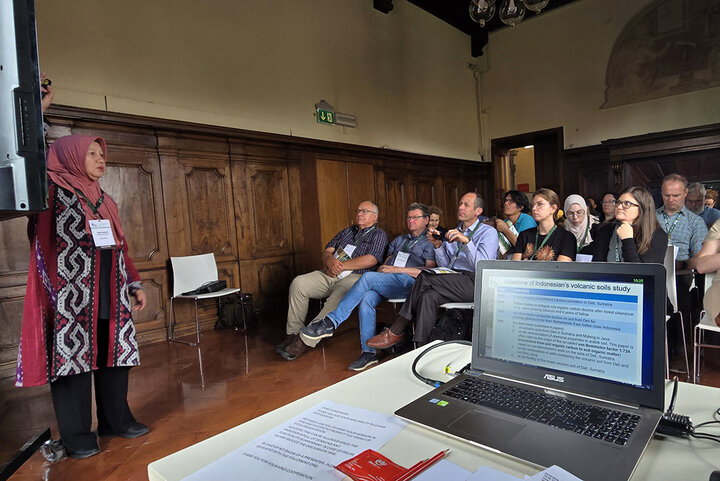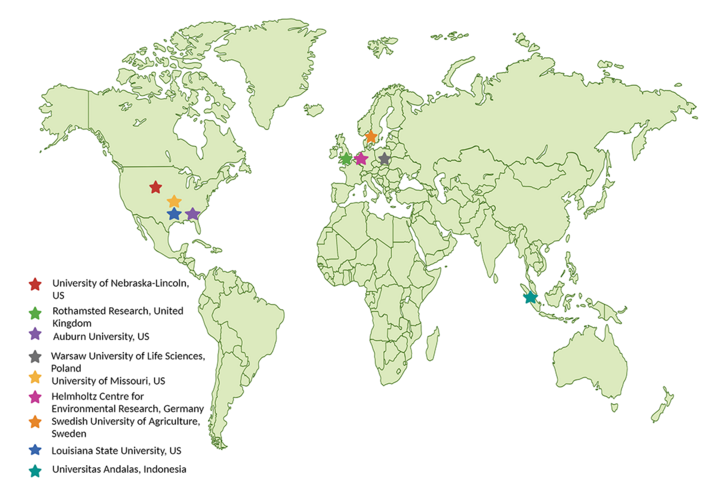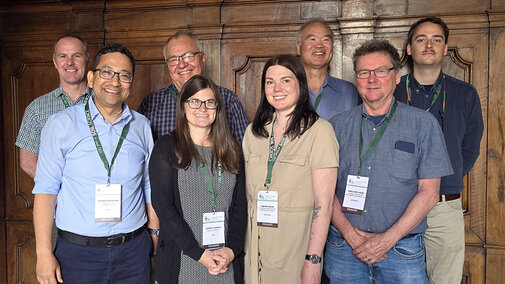Established in 1924, the International Union of Soil Sciences (IUSS) is the global union of soil scientists contributing to both nature and human well-being. On May 19, the IUSS held a three-day centennial celebration in Florence, Italy, focused on the past achievements and future challenges of scientists and specialists from different disciplines.
At this IUSS event, one session was dedicated to soil science lessons from 100-plus-year-old experiments.
Bijesh Maharjan, the supervisor of the Knorr-Holden Plot in Nebraska — one such historic experiment — chaired the session. Maharjan, an associate professor at the University of Nebraska-Lincoln (UNL) and extension specialist in soil and nutrient management at the Panhandle Research, Extension, and Education Center (PREEC), intended to bring generations of soil scientists’ commitment to agriculture and research to the global stage.
In accordance with the primary reason behind the session, Maharjan said “we want to follow the footsteps of our visionary past scientists who initiated and maintained these historical research sites and be strategic and forward-looking by bringing all these unique and rare historical research together to enhance our understanding of agricultural sustainability, the prime need of the hour.”

In chairing the session, Maharjan likewise aimed to lift Nebraska’s agriculture history and research contribution to the level of other well-known historical experiments. He presented long-term research from the historic Knorr-Holden continuous corn production system at the IUSS event. Established in 1910 and entered on the National Register of Historic Places in 1992, the Knorr-Holden plot near Scottsbluff, Nebraska is potentially the world’s oldest irrigated continuous corn research plot.
During the session, scientists shared their findings from their 100-plus-year-old experiments, emphasizing the invaluable importance of the impact of agriculture on the environment at the national and international level. The session brought together scientists representing most of these exceptionally established research experiments from across the globe. Not only were there scientists representing institutions from the United States — the UNL, Auburn University, Louisiana State University, and the University of Missouri — but scientists also represented institutions from the United Kingdom, Poland, Germany, Sweden, and Indonesia (Figure 1).
Andy Gregory, head of the Rothamsted long-term experiments (LTEs) in the United Kingdom, was the keynote speaker at Maharjan’s session.
“I decided to frame my presentation in terms of ‘gradients of soil health’, because that is what the treatments imposed for well over a century at Rothamsted have created,” Gregory said. “We may demonstrate the link between management in agricultural systems and various important functions we ask of our soils, such as support for crop growth, regulation of water and air, and climate change mitigation, all of which underpin soil health.”
Collectively, attendees in Maharjan’s session emphasized the substantial benefits of historical research plots to education, crop productivity, and promoting agricultural sustainability while bridging the past with the future.
“The ‘Old Rotation’ (in Alabama) is a valuable educational resource for students, farmers, and agricultural scientists to learn more about the long-term effects of different farming practices on soil health, crop yields, and environmental impacts,” said Audrey Gamble, from Auburn University. “Their ability to connect the past with the present helps to support the educational, research and service missions of universities.”
Hans-Jörg Vogel from Germany noted that LTEs provide essential data that capture the complexity and long-term trends of soil processes. As such, LTE data are indispensable for developing, validating and refining systemic soil models, leading to more accurate predictions of future developments.
“Long-term experiments function both as a field laboratory, where long-term management has created a great variation of factors between plots, and as a reference material for the long-term impact of various management practices on soil and crop properties,” said Sabina Braun, a researcher from the Swedish University of Agriculture Sciences. “The LTEs play an invaluable role in Swedish agriculture and environmental research, policy making, and teaching.”
Across the globe, the handful of remaining LTEs not only continue to function as research entities but have begun to enlighten scientists and others to the lasting effects of management practices and climate trends on agriculture sustainability.
Lukasz Uzarowicz, from Poland, emphasized that observations of long-term trends from LTEs may be the basis for creating forecasts of changes in crop yields and the rate of sequestration or loss of organic carbon in the soil in the context of climate change.
“These forecasts can be used by decision-makers at the national and international levels to develop agricultural development strategies and introduce good practices to reduce agriculture's impact on the environment, including the climate,” Uzarowicz added.

Though LTEs have substantial benefits, maintaining their continuity in the competitive grant funding system can be a long-term challenge. Tim Reinbott, director of the University of Missouri’s Sanborn Field, noted most grant funding awards are for only three to five years, and the time in between grant awards is a dangerous time for continuing the long-term research sites if financial commitments are not made by the stakeholders. Too often, long-term research sites in the 10-50 years after establishment are terminated due to lack of funds.
“Consistent soil and crop sampling and archiving of these samples is critical as that enhances the value of the experimental for future generations,” Reinbott said. “The biggest challenge for many long-term experiments is consistent funding to ensure that there are not breaks in data collection.”
Inspired by their harmonious efforts as stewards of LTEs, Maharjan’s IUSS session members intend to stay connected and continue the new collaboration. Efforts are being coordinated to share research strategies to enlighten and educate the LTE stewards. An example of their continued connection will be the organization of a spring 2026 conference at the Institute of Agriculture, Warsaw University of Life Sciences, related to celebrating centennial LTEs.
“I am planning to organize and welcome all to the conference devoted to LTEs and their role in science and society, connected with the celebration of centennial of LTEs belonging to the Warsaw University of Life Sciences,” Uzarowicz said. “We are also planning to organize a visit at our Experimental Station in Skierniewice, central Poland, where we have our oldest LTEs.”
Gregory, with Rothamsted Research, further emphasized the importance of LTEs and the new collaboration on the global stage.
“Although Rothamsted has the oldest set of agricultural LTEs, I genuinely feel that we are but one member of a global family of LTEs,” he said. “The future lies in closer links between these invaluable global resources so that we may maximize their potential to support new research that addresses the key societal challenges of sustainable agriculture, food security and climate change.”
This centennial IUSS event has brought together a collaboration between scientists dedicated to preserving long-term science and their capability to further an international link to enhance our understanding of agriculture sustainability.

